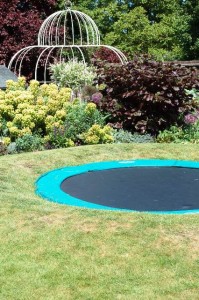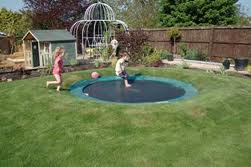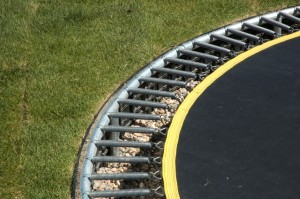How to sink a trampoline in the ground
 Sunken Trampoline with Donut Surround(Dawn Isaac Garden Design)
Sunken Trampoline with Donut Surround(Dawn Isaac Garden Design) It is becoming increasingly popular to install your trampoline in the garden at ground level by sinking it into the ground. This has a number of advantages, firstly a sunken trampoline is less visible so will be less obvious and will not spoil the look of your garden as much as it might do otherwise. Also, with a sunken trampoline you do not need a trampoline safety enclosure, which can look unslightly and saves money too. Secondly, there is less distance for people to fall off a sunken trampoline and injure themselves and thirdly younger children can play on the sunken trampoline without needing assistance in getting on it and with less risk of them falling off. Fourthly, you will not need to move the trampoline at intervals to avoid damage to the grass underneath or when cutting the grass.
One leading garden designer says, "I think a sunken trampoline has to be my favorite family garden feature. It's a simple enough idea but solves so many headaches. It's safer, less intrusive and popular with everyone."
Here are some tips if you are considering sinking a trampoline in your own garden:
- Size - work out what size of trampoline is appropriate, how much space have you got where the ground is suitable to be dug out but remember there's the cost of digging the hole and getting rid of the spoil. Also consider that as your children get older they will want a larger trampoline for them (and their friends!). We normally suggest getting the largest trampoline you can afford and which will fit the space available to use. Bear in mind you will need a space of about 1 meter around the sunken trampoline as a safety zone, or for the donut (see below). Tip: dig some trial pits first to make sure the area you have chosen has diggable soil to an adequate depth.
- Shape & Colour - most garden trampolines are round as these naturally gravitate the bouncer to the centre of the trampoline which is the safest and the most powerful spot to bounce on. A rectangular trampoline might not be so asthetically pleasing in a garden and a hexagonal shape will make digging the hole much more difficult. A contrasting colour for the spring padding is essential so it is clear to anyone where the garden stops and the trampoline starts.
- Buy the trampoline - Atlantic Trampolines offer a wide range of sizes to suit most requirements. Their trampolines are well made and will last many years. The trampoline frames are hot dip galvanised on the inside and outside to maximse the protection from rust which is essential when the legs of the trampoline may be stood in water for long periods when sunken in the garden. Atlantic Trampolines offer next day delivery across the UK mainland, and delivery abroad is offered aswell. You can buy online at www.atlantictrampolines.co.uk or you can call their Freephone Trampo-line on 0800 032 5879 and talk to one of their helpful team who are experienced in all aspects of trampoline installations. Tip: it pays to buy a good quality trampoline as it is likely to be a long term fixture in your garden and you don't want to have to replace it too frequently.
- Mark the sunken trampoline site - you will need to mark the area to be excavated. This needs to be done with some accuracy so the hole is exactly the right size. If it is a round trampoline then do this by securing one end of a tape measure at the central point using a stick or screwdriver and mark the circumference by running in a circle of the correct radius with spray paint or some flour to mark the edge of the hole to be excavated.
- Dig the hole - This can be done by hand or using a small mechanical digger. You might find a local contractor who can do this quite cheaply although I've known people treat it as a daily exercise task and completed it over a couple of weeks. Try to pick a dry period which will make it easier whichever way you do it.
- What to do with the soil - If the area has good quality turf then remove this and lay to oneside. Keep it watered if necessary. The first foot or so of soil you remove will be top soil and should be saved. Under the top spoil will be subsoil which can be removed from site or saved in a unobtrusive area of the garden incase you, or future owners, want to refill the hole. You may need some to create the donut (see below). Tip: Don't underestimate the work involved and arrange help if necessary.
- Hole depth - the hole depth should equal the height of the trampoline so once installed it is at ground level. Some people advise having the trampoline just above the surface of the ground by about 4 inches to allow the air to escape when bounced on. The difficultly is this causes a trip hazard, might mean limbs could get trapped and allows things to get lost under the trampoline. A better way to deal with the air movement issue is to use air vents described below.
- Drainage- the hole underneath the sunken trampoline will need to drain well if it rains or the children use the garden hose on the trampoline. If the ground is usually heavily water logged then a sunken trampoline might not be possible. If the area drains slowly you can create a soakaway in the bottom of the pit by digging an extra trench across the hole and filling this will gravel or hardcore (a form of French drain).
- Preventing edge collapse - you may need to consider how to maintain the integrity of the walls of the the hole. If your soil is firm this should not be a problem. If you have sandy soil you may need to consider a wall support system like that sold by trampolinesdownunder.com.
- Air movement - as people bounce on the trampoline air needs to flow freely in and out of the hole. Rather than leave a gap around the trampoline I suggest installing at equal intervals perhaps 4 lengths of 4" flexible pipe from just below the surface of the hole to a distance away from the trampoline. This allows the air to escape and re-enter easily, it also makes a fun feature for the children to play with.
- Creating a donut - a nice idea is to create a raised"donut" ring around the trampoline as in the photo above. This helps to partly obscure the trampoline, makes it more fun as the children can jump from the top of the ring on to the trampoline or run down the slope on to it. Using some of the excavated soil build a ring around the trampoline with slopes either side and a flat top. Any turf saved earlier can be used to cover it and by laying it over the edges of the hole you can fill any gaps between the hole edge and the trampoline.
 Garden level trampoline (Dawn Isaac Garden Design)
Garden level trampoline (Dawn Isaac Garden Design)If you have any comments then please leave them as a comment to this blog. We would be interested to know if you have encountered any other problems and how you have overcome them.
If you follow these guidelines though you should end up with a very satisfactory solution to sinking your trampoline in the ground.
Please contact us if you require further guidance on sinking a trampoline into the ground. All Atlantic Trampolines are suitable for in-ground installations.
Author: Bob Bounce
Atlantic Trampolines
Latest Twitter Updates
- A Floating LED Pool Light makes a great accessory for any of our Lay-Z-Spas. Great value at £22.99 each https://t.co/IXei92hhSS
- 167 days ago Via Unknown
- The Skywood Play Tower is a modular play system which enables you to design and expand your play equipment to suit the space available and your child’s own interests be it sliding, swinging or digging in a sandpit. Call our sales team if you need advice
- 167 days ago Via Unknown
- The TP Robin Multiplay is an option if you only have smaller garden. It offer a number of activity options including a swing and slide https://t.co/RVGm5z2xr8
- 167 days ago Via Unknown
- Giant 4 in a Row is a consistently popular choice. Fun way to teach children logic, it can be played inside and out by all ages. #funtoys https://t.co/GuVzjbLYtd
- 169 days ago Via







